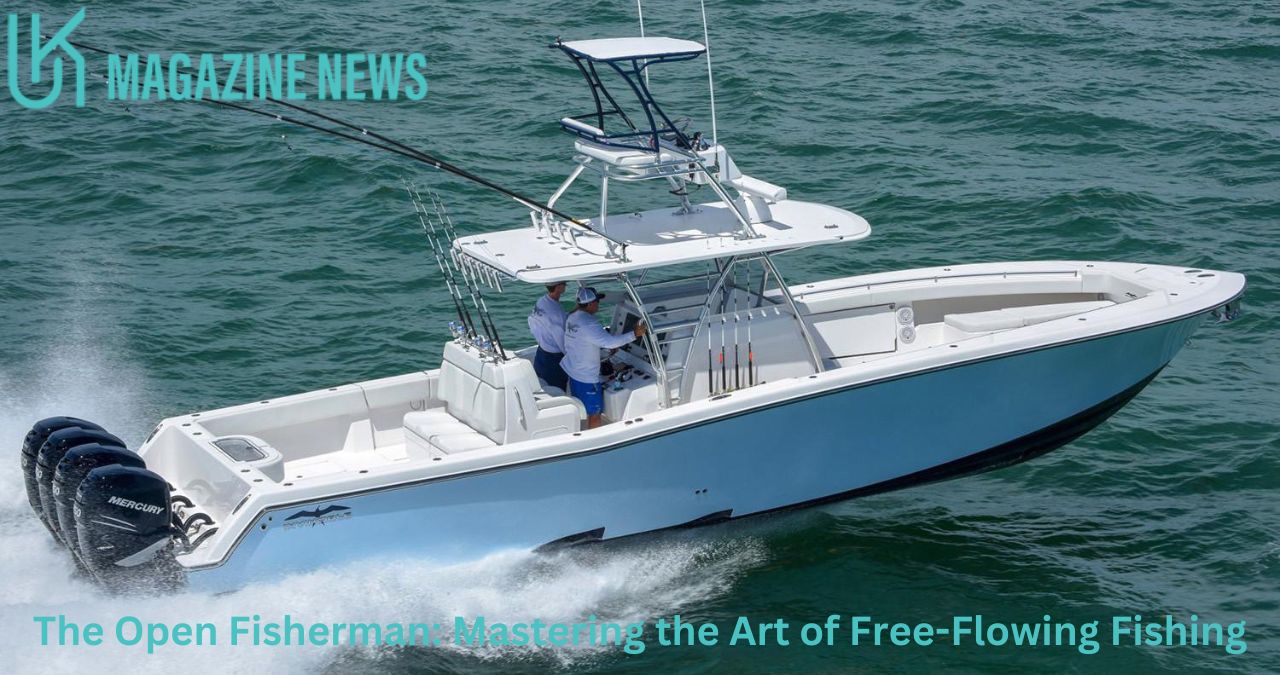Fishing has been a vital part of human culture for millennia. From early humans relying on the seas for food to modern-day sport fishing enthusiasts, the call of the open water continues to attract people from all walks of life. For those who choose to embrace the lifestyle, the concept of the “open fisherman” represents a unique and liberating approach to the craft. It’s not just about casting a line into the water; it’s about embracing the open seas, the adventure, and the freedom that comes with fishing beyond the confines of land-based limitations. In this article, we’ll explore the art of free-flowing fishing and how you, as an aspiring open fisherman, can master this way of life.
What is an Open Fisherman?
The term “open fisherman” refers to someone who fishes beyond the confines of a traditional dock, shore, or inland waterway. It’s about embracing the open water—whether it’s the deep sea or wide, uncharted lakes—and fishing with a sense of freedom. The open fisherman is someone who casts away from the shore, often venturing into less-trodden waters where fish are abundant but the conditions can be unpredictable.
For many, becoming an open fisherman means stepping outside their comfort zone. It involves using a variety of fishing techniques suited to different water bodies, tools, and unpredictable weather conditions. It’s about being adaptable, resourceful, and prepared for the challenges of fishing in open environments. This approach allows for a richer and more rewarding experience, as it merges skill, patience, and the excitement of the unknown.
The Spirit of the Open Fisherman
At its core, the spirit of the open fisherman is one of independence and resilience. Unlike traditional fishermen who may rely on fixed spots, regular bait, and predictable conditions, the open fisherman embraces uncertainty. They must be prepared for varying conditions, whether that means navigating rough seas, dealing with changing tides, or fishing in locations with few resources. It’s about being self-reliant—trusting your skills, knowledge, and intuition to succeed in an environment where nothing is guaranteed.
This freedom to explore the waters is what draws so many to the open fisherman lifestyle. The open fisherman thrives on variety and adaptability, and they understand that every day spent on the water presents new challenges and opportunities. They’re often explorers at heart, eager to push beyond the borders of where others fish and see what lies beyond the horizon.
Essential Gear for the Open Fisherman
To truly embrace the life of an open fisherman, one needs the right equipment. Fishing in open waters is different from fishing from the shore, and the gear you use must reflect that. Below are some of the essential tools and equipment that every open fisherman should have in their arsenal.
1. Versatile Fishing Rods and Reels
An open fisherman needs a rod and reel that can handle various conditions, from calm lakes to choppy seas. Rods with medium to heavy power are ideal for the unpredictable nature of open water fishing. A good quality spinning or baitcasting reel will offer the versatility needed to deal with a wide range of species and water conditions.
2. Tackle Boxes with Customizable Compartments
Open water fishing often means encountering different fish species with varied habits. A tackle box with customizable compartments allows you to bring a diverse range of baits, lures, hooks, and sinkers. This way, you’ll always have the right tools for whatever type of fish you encounter.
3. Safety Gear
Safety is a top priority for the open fisherman. Along with basic personal flotation devices (PFDs) for all members of your crew, make sure you have appropriate weatherproof clothing, sunscreen, and a well-stocked first aid kit. A waterproof dry bag for your electronics, such as phones or GPS devices, is also a must.
4. Fish Finder and GPS
Technology can be an open fisherman’s best friend. A fish finder will help you locate fish and understand the depths of the water you’re fishing in, while a GPS ensures you can navigate back to your starting point even in unfamiliar waters. Modern fish finders even include sonar capabilities, offering detailed underwater views.
5. Boat and Motor
The boat is your vehicle for reaching new waters. Depending on the type of fishing, you may need a larger, more robust boat designed for open seas or a smaller, lighter craft for lakes and rivers. A reliable motor is crucial for navigating through rough waters, and for longer trips, extra fuel can be a lifesaver.
Key Techniques for Free-Flowing Fishing
Mastering the art of free-flowing fishing isn’t just about the gear you use—it’s also about the techniques you apply. Whether you’re fishing from a boat, kayak, or stand-up paddleboard, certain techniques can increase your chances of a successful catch.
1. Drifting
One of the most effective techniques for open fishermen is drifting. This involves letting the boat naturally float with the current or wind, allowing your bait to cover a larger area without the need for constant re-casting. Drifting is particularly useful when targeting species like bass, walleye, or even larger saltwater species. It’s important to match your drift with the current to ensure your bait stays at the right depth.
2. Trolling
Trolling is a method of fishing in which baited lines are drawn through the water behind a moving boat. This technique is especially effective for catching large, mobile fish like tuna, salmon, and pike. Trolling allows you to cover a large area of water and present your bait at different depths, making it an excellent way to target fish that aren’t stationary.
3. Casting and Retrieving
Casting and retrieving is perhaps the most straightforward technique, but its effectiveness is all about timing. It requires precision and attention to the fish’s behavior. Casting lures or baits into areas where fish are known to feed, and then reeling them in at the right speed and depth, is essential for success. When fishing in open water, consider using different retrieval speeds and techniques to mimic the movements of the prey.
4. Bottom Fishing
Bottom fishing involves lowering bait to the bottom of the water, where many fish species like grouper, snapper, and halibut reside. This technique is highly effective in deeper waters and when fishing from a boat. Using heavier weights will help keep your bait close to the bottom, and it’s crucial to use a sturdy rod and reel to manage the larger fish species found at these depths.
Navigating the Challenges of Open Water
Fishing in open waters isn’t without its challenges. The ever-changing environment—ranging from unpredictable weather to varying water conditions—requires the open fisherman to be adaptable and prepared for anything. Below are some common challenges and how to overcome them.
1. Unpredictable Weather
Weather conditions on the open water can shift rapidly. A calm morning can give way to a violent storm in a matter of hours. For this reason, the open fisherman needs to stay vigilant and informed, checking weather forecasts regularly and always having a contingency plan. Knowing when to head back to shore before the weather turns is a key skill.
2. Dealing with Rough Seas
Rough seas can make fishing in open waters both difficult and dangerous. If you’re fishing from a boat, be sure it’s equipped for the conditions you’re likely to encounter. For smaller boats, avoid venturing out in choppy seas, as they can be hard to navigate and increase the risk of capsizing.
3. Navigational Difficulties
In vast open waters, it’s easy to get disoriented. This is why having a reliable GPS system and understanding how to use a compass are essential skills for an open fisherman. Always mark your starting and ending points before setting off on your fishing journey.
The Rewards of Open Water Fishing
The allure of open water fishing lies in its unpredictability and the thrill of the chase. Whether it’s reeling in a record-sized fish, exploring new fishing grounds, or simply enjoying the solitude of the wide-open waters, the rewards of being an open fisherman are multifaceted.
Fishing in these environments offers a deeper connection to nature and a sense of freedom that can’t be matched on the shore. For many open fishermen, the joy lies not only in the catch but in the journey itself—the challenge of mastering the water, adapting to conditions, and testing their limits.
Conclusion
Becoming an open fisherman is about embracing freedom—the freedom to explore uncharted waters, the freedom to adapt your fishing techniques to your environment, and the freedom to experience nature in its rawest form. By arming yourself with the right gear, mastering various fishing techniques, and preparing for the unpredictable challenges of open water, you’ll be well on your way to becoming a skilled open fisherman.
In the end, it’s not just about fishing; it’s about living the adventure. The open fisherman is a seeker, a traveler, and a master of his craft, and there’s no better time than now to begin your own journey. So, cast away from the shore, embrace the open waters, and let the adventure unfold.





